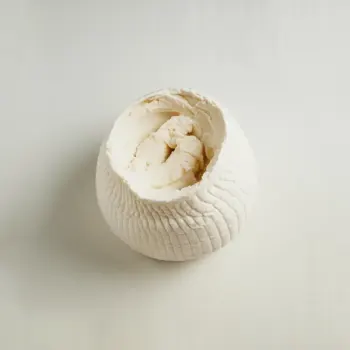Goat cheese and ricotta are two distinct types of cheese commonly used in cooking. Goat cheese is tangy and can range from crumbly to creamy, while ricotta is mild, slightly sweet, and has a grainy texture. Each cheese offers unique flavors and textures to various dishes from salads to baked goods and pasta.

Goat cheese, also known as chèvre, is a tangy, creamy cheese made from goat's milk. It comes in many forms, from soft and spreadable to firm and mold-ripened. Its distinct flavor can range from mild to robust, depending on its aging process.

Ricotta is a soft, moist, and slightly sweet cheese made from the whey left over from the production of other cheeses. Originating from Italy, ricotta has a grainy texture and is popularly used in both sweet and savory dishes.
Goat cheese is known for its strong, tangy, and sometimes earthy flavor, which becomes more pronounced as it ages. It has a crumbly to creamy texture, depending on its form. Ricotta, on the other hand, is much milder with a slightly sweet taste and a grainy, moist texture. Goat cheese is made from whole goat's milk, while ricotta is traditionally made from the whey of cow's milk, although it can also be made from goat, sheep, or Italian water buffalo milk.

Your ultimate Recipe Box, Meal Planner, and Cooking Class all in one
Goat cheese is ideal for salads that benefit from a crumbly texture and bold flavor, such as beetroot salad or arugula salad with nuts. Its creaminess contrasts well with vinaigrette dressings and can hold its own alongside strong-flavored greens. Ricotta works well in fruit salads or greens with a mild flavor, like spinach or butter lettuce. It adds a mild, creamy element without overpowering other ingredients. Dollops of ricotta can be blended smoothly into dressings for a richer, creamier texture.
Use goat cheese for savory baked goods like tarts, quiches, or puff pastries. Its strong flavor complements ingredients like spinach, mushrooms, and caramelized onions. Goat cheese can also be incorporated into savory scones or biscuits. Ricotta is a common addition to sweet baked goods such as cheesecakes, cannoli, and ricotta cookies. Its mild flavor and moisture content make it excellent for creating a tender crumb in cakes and muffins.
Goat cheese is perfect for pasta sauces that require a bit of tang and creaminess, like a goat cheese and spinach pasta. It melts well and can add complexity to pesto or a simple olive oil toss. Ricotta is traditionally used in lasagna, stuffed shells, and manicotti. It provides a creamy, rich filling and pairs well with tomato-based sauces and herbs like basil or oregano.
Both goat cheese and ricotta offer nutritional benefits, including protein and calcium.
| Nutrient | Ricotta ( per Ounce ) | Goat Cheese ( per Ounce ) |
|---|---|---|
| Fat | 2g | 8g |
| Sodium | 30mg | 130mg |
| Calcium | 51mg | 40mg |
| Protein | 3g | 6g |
| Calories | 39 | 103 |
| Carbohydrates | 3g | 1g |
Yes, you can use goat cheese instead of ricotta in lasagna for a tangier flavor, but be aware that the texture and taste will be quite different.
Both cheeses have their own health benefits, but goat cheese is higher in fat and calories while ricotta is lighter, making it a better option for those counting calories or fat intake.
Goat cheese should be wrapped in parchment paper and then placed in a sealed container in the fridge. Ricotta should be kept in its original container with a tight lid or transferred to an airtight container and refrigerated.
Absolutely, goat cheese can be used in desserts, particularly in cheesecakes or tarts, where its tangy flavor complements sweet profiles.
Ricotta is traditionally used for stuffing pasta shells due to its creamy texture and mild flavor, but goat cheese can also be used for a more robust flavor.